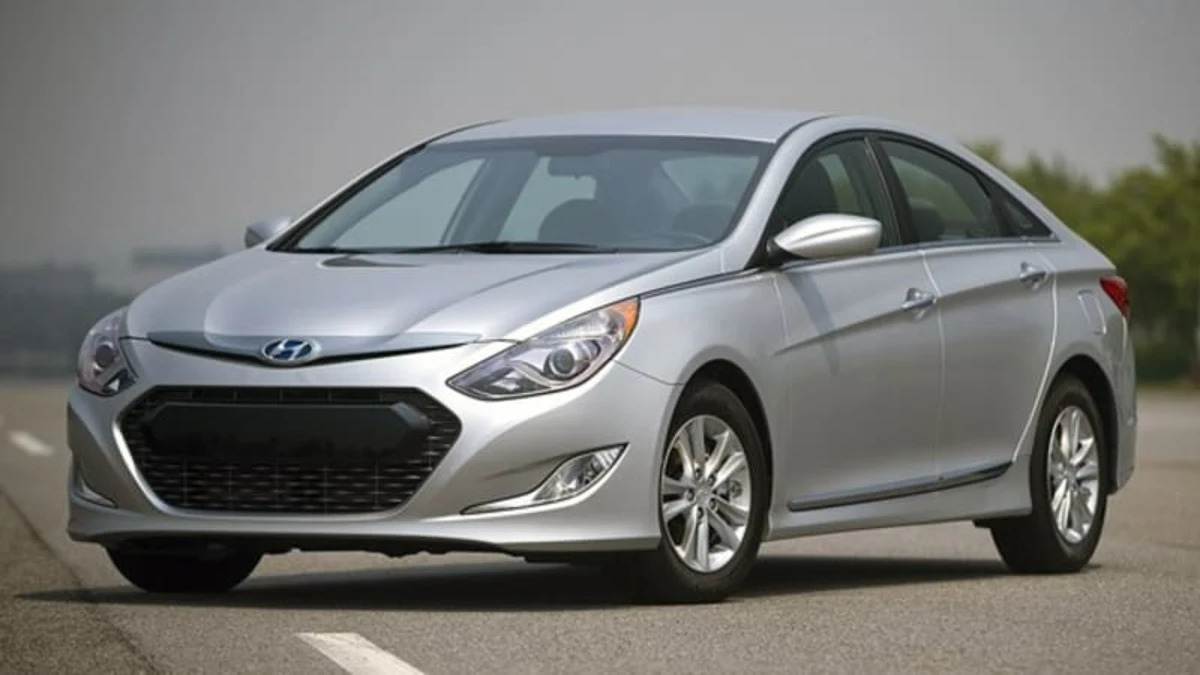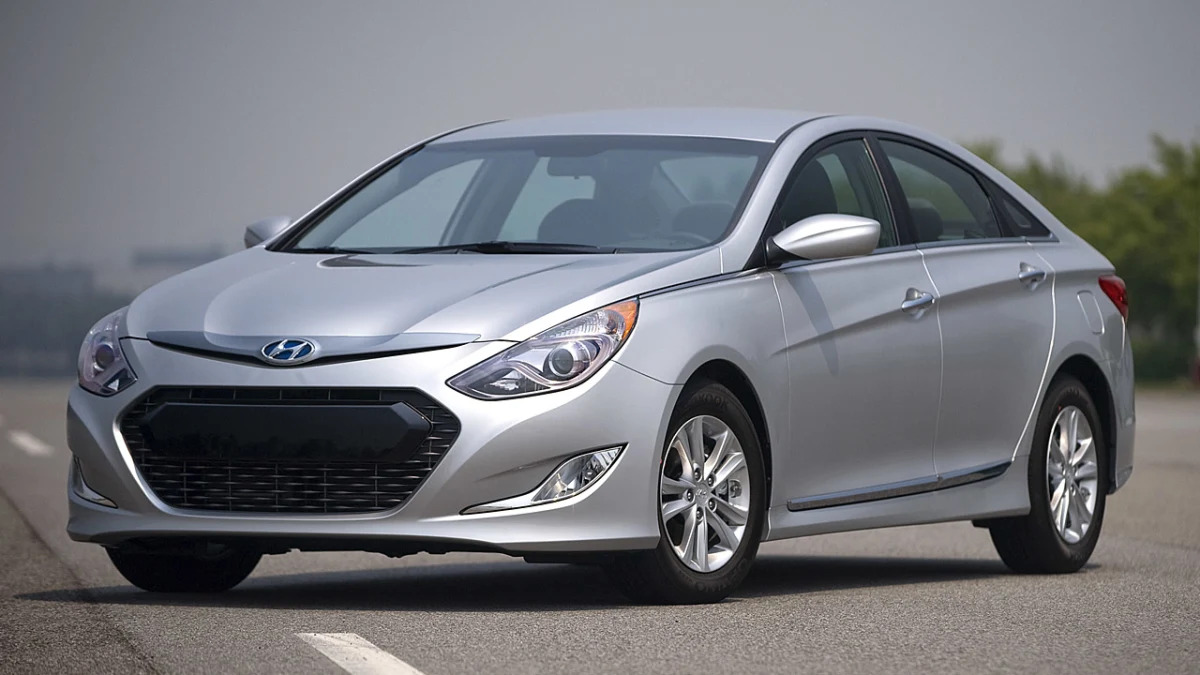2011 Hyundai Sonata Hybrid – Click above for high-res image gallery
Perhaps we shouldn't be surprised that the 2011 Hyundai Sonata Hybrid hails from a nation where Buddhism is one of the dominant religions. After all, this slippery sedan's design is the gas-electric's equivalent of The Middle Path – a road that the company hopes is truly the way to automotive enlightenment.
Say what?
In the still-young history of the modern hybrid automobile, there have been two prevailing schools of thought on design: As the less costly path, The Low Road to hybridization is already a crowded one – it's a design route that basically calls for the electrification hardware to be buried beneath a familiar bodyshell that's shared with a conventional internal combustion-only model (see: Lexus LS 600h, Ford Fusion Hybrid, Chevrolet Silverado, etc.). The driving philosophy here is to keep production costs in check while also appealing to audiences that might be otherwise reluctant to embrace "new" technology.
Despite being on the checklist of every politician, environmentalist and Hollywood glitterati, hybrids don't sell in America
By contrast, The High Road calls for swoopier model-specific bodywork – if not an entire dedicated platform – enabling a "greener than thou" halo for its owners and parent company. Unfortunately, this high-visibility strategy also costs a boatload of cash, and the only such model that has managed to make a solid business case for itself is the Toyota Prius, a vehicle that's become the de-facto postercar for the green movement.
But here's the conundrum that Hyundai has keenly recognized: Despite being on the checklist of every politician, environmentalist and Hollywood glitterati, hybrids don't sell in America – they account for less than two percent of new vehicles purchased in the U.S. every year, and their high technology bandwidth means that they require a disproportionate amount of money to develop. Basically, Hyundai knows that the Sonata Hybrid is a necessity for improving its technological capabilities, as well as for burnishing its industry-leading CAFE scores, but it also seems to understand that it is almost certain to lose money on each one it builds. Which is why they've taken The Middle Path.
In this case, the Sonata Hybrid tries to integrate the best of the other two hybrid strategies – create a distinctive new model with a unique look that says "I care more about the earth than you do" without incurring the cost of a whole new platform and all-new sheetmetal. Have they been successful? We flew all the way to South Korea to find out...
While it shares its platform, doors, glass and roofline with the conventional gas-powered models, the Sonata Hybrid has a surprisingly assertive look all its own. Just check out its gaping hexagonal air inlet with a floating bumperette and license plate holder – it looks nothing like the controversial wavy slat assembly on the gas Sonata. The same goes for the piercing new headlamps with integrated light tube ribboning, as well as the wing-shaped chrome garnish on the hood's leading edge. The Sonata Hybrid's visuals are actually bold enough that one could be forgiven for thinking that Hyundai might have reserved it for the forced-induction 2.0T model. We wouldn't call it a pretty face, but it's clearly got aggression to spare.
Move along the Sonata Hybrid's profile, and you first notice the KitchenAid-spec 16-inch alloys and the subtle rocker panel extensions employed for better aerodynamics. Out back, the rear bumper cap has also been resculpted to more cleanly detach air (notice the harder-edged lines around the corners), and a blacked-out lower fascia helps to visually lighten the design. The Sonata Hybrid's coolest design element? Its clear rear lights, because the brake lamps appear to incorporate an atom symbol graphic when lit. All of those changes help drop the coefficient of drag from a slick 0.28 cD to a positively eel-like 0.25.



The Sonata Hybrid's Middle Path approach continues beneath the skin. While Hyundai is the first to make use of lithium polymer batteries in a mass-production hybrid, it also incorporates some more common hardware, including a conventional six-speed automatic it shares with other Sonata models. By eschewing the complexity of a continuously variable transmission, Hyundai has cut costs while delivering a driving experience that's closer to that of a normal internal combustion vehicle. In this application, the house-developed gearbox is attached directly to the electric motor – there is no torque converter. A small clutch pack with an electric oil pump can uncouple the 169-horsepower 2.4-liter Theta II engine entirely, allowing the 30 kW motor to deliver its 151 pound-feet of torque, whirring car and driver noiselessly to speeds up to 62 miles per hour.
Although Hyundai hasn't downsized the Sonata's gasoline engine for hybrid duty, it has converted it to run on a more efficient cycle. While abandoning Nicolaus Otto for James Atkinson generally results in improved fuel economy, it also comes at the expense of low-end torque (in this case, 156 lb-ft at 4,500 rpm). Conveniently, twisting down low is exactly the electric motor's strong suit, so it picks up the slack to help the Hybrid deliver a more traditional driving experience.
Additional good news arrives in the form of the Sonata Hybrid's LiPo battery pack. It may have cost more than a nickel metal hydride solution, but Hyundai claims that the magazine-like prismatic cells offer greater robustness and lighter weight than other batteries. Compared to the yestertech NiMH pack in the Toyota Camry Hybrid, Hyundai claims that its 1.4 kilowatt-hour pack is 20-30 percent lighter, 40 percent smaller, and a tenth more efficient. You might expect for this to pay dividends in the area of cargo capacity (the batteries are located in the trunk), but in truth, the Hyundai's 10.7 cubic-foot trunk is still dramatically smaller than that of a gas-only Sonata (16.4 cubes) and it's about the same size as its competitors. Even if the flat-pack configuration doesn't help free up more luggage space, Hyundai says the cells have improved thermal efficiency to help prolong life – the company's durability targets for the pack stands at 10+ years and 150,000 miles.
Thanks in part to the LiPo batteries and the Sonata's already light construction, the Sonata Hybrid checks in at 3,457 pounds, meaning that not only does it weigh a good bit less than the Ford Fusion Hybrid (along with the rest of its rivals), it actually undercuts the Blue Oval's sedan in V6-flavor.

Unfortunately, we didn't really get a feel for how this lightness impacts handling because we were limited to very brief, largely straight-line runs in prototypes at Hyundai's Namyang Proving Ground outside of Seoul. What we can tell you is that at first blush, the Sonata Hybrid accelerates and shifts gears like a normal family sedan. By this we don't mean "normal for a hybrid"– it just gathers speed in an utterly familiar, drama-free fashion. Yes, if you're reserved with the throttle, you'll generally be able to accelerate to around-town speeds without awakening the 2.4-liter until the battery's depleted, but when driven as you would normally, you'll realize that Hyundai's decision to go with a conventional stepped gearbox over a CVT was a smart choice as the drivetrain acts and sounds like any other four-cylinder powertrain – no wonky stretched rubber band sensation or soundtrack that many CVT units deliver. We did notice a couple of incidents where the transmission 'clunked' a bit from gear to gear under part throttle, but Hyundai engineers acknowledge that they still have some bugs to work out before the car enters production.
Hyundai quotes a total combined power estimate of 209 horsepower at 6,000 rpm and 194 pound-feet of torque. Both figures are actually slightly better than the gas-powered Sonata's 198 hp and 184 lb-ft, although obviously the Hybrid is heavier. The gas-only car already has class-leading fuel economy figures of 22 miles per gallon in the city and 35 on the highway, while Hyundai estimates the hybrid will drum up 37 mpg in the urban cycle and 39 mpg out on the highway. As we've already observed over 40 mpg on the highway in a non-hybrid Sonata, we're guessing that the factory estimates may be under-reported a bit. Even still, as with most hybrids, you're really only likely to garner huge fuel savings – about 40 percent – if most of your driving is conducted in the city, not out on the open road. Either way, Hyundai has yet to officially reveal any other performance metrics, but we did note a Powerpoint slide suggesting 0-62 mph in 9.2 seconds, which seems a tad conservative.

The Sonata Hybrid's cabin is nearly identical to other models in the range, with its most noticeable departure being the 4.2-inch LCD sandwiched in the middle of the gauge cluster. It displays the usual types of data for a gas-electric vehicle – mpg, EV-mode, energy flow diagrams and so on. As is the way these days, there's also a video game-like mode to tell the driver how eco-conscious he or she is being, with points accumulated over time and a visual efficiency telltale that ranges from gray to bright blue. Beyond the gizmology, interior differences are expected to include a hybrid-specific color option as well as different seat patterns. All of which is fine by us, as the Sonata already has one of nicest interiors in the family sedan segment (though we admit we're getting a bit tired of the blue gauge backlighting).
We'll have to wait to arrive at a verdict on the Sonata Hybrid until pricing is revealed and we get substantially more time behind the wheel of a production model, but thus far, it looks pretty compelling. Treading The Middle Path for its development has not only saved Hyundai cost in certain areas (e.g. shared body panels and transmission), it's enabled the company to splash out and go for broke in the ones that are important (LiPo batteries, distinct front-and-rear ends). Will it lead to a state of euphoric enlightenment for hybrid shoppers? Hyundai sure hopes so.







Sign in to post
Please sign in to leave a comment.
Continue